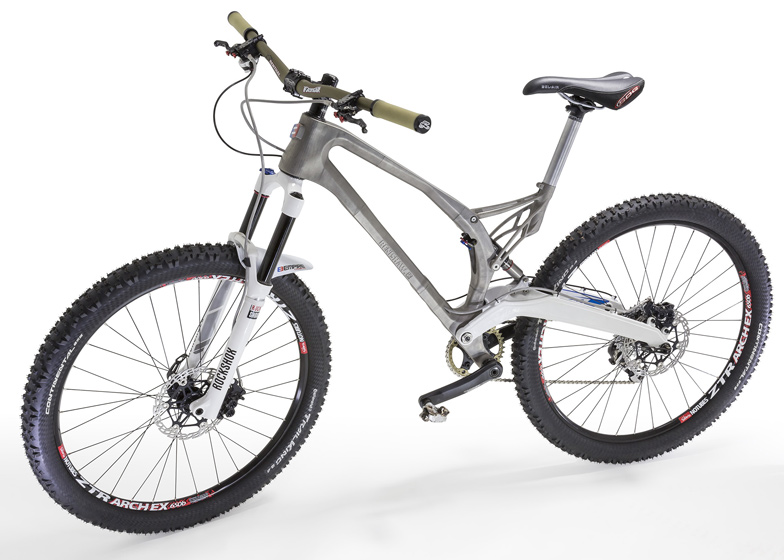News: British bicycle brand Empire Cycles has collaborated with additive manufacturing company Renishaw to build the world's first 3D-printed metal bike frame.
Using a 3D printer developed by Renishaw to print metal parts, Empire Cycles has created a titanium alloy frame that is over a third lighter than a traditional frame, increasing design flexibility while reducing production costs.
"The key benefit for Empire Cycles is the performance advantages that this construction method bestows," says the brand, which first approached Renishaw with its design.
"As no tooling is required, continual design improvements can be made easily, and as the component cost is based on volume and not complexity, some very light parts will be possible at minimal costs."
According to the brand, 3D printing makes the frame for the MX-6 Evo bike lighter without forfeiting strength by using topological optimisation - the process where material is removed from areas of low stress until the design is optimised for load bearing. Using as little material as possible means the frame is at its lightest.
Even though titanium is more dense than the aluminium alloys that Empire Cycles normally uses, topological optimisation allows the weight of the bicycle to be reduced to 1400 grams, which is 33 percent lighter than the previous 2100 grams.
While some carbon fibre bikes are lighter, Empire Cycles says this frame is more robust. "The durability of carbon fibre can’t compare to a metal bike," said Chris Williams, managing director of Empire Cycles.
"They are great for road bikes, but when you start chucking yourself down a mountain you risk damaging the frame. I over-engineer my bikes to ensure there are no warranty claims," he added.
Here's a press release from Renishaw:
First metal 3D printed bicycle frame manufactured by Renishaw for Empire Cycles
Renishaw, the UK's only manufacturer of a metal-based additive manufacturing machine that prints metal parts, has collaborated with a leading British bicycle design and manufacturing company to create the world's first 3D printed metal bike frame. Empire Cycles designed the mountain bike to take advantage of Renishaw's additive manufacturing technology, allowing them to create a titanium frame that would be both strong and light using topological optimisation - the new frame is some 33% lighter than the original.
The frame has been additively manufactured in titanium alloy in sections and bonded together. This offers a number of advantages:
Design freedom
» Rapid iterations; flexibility to make design improvements right up to production
» Ability to make shapes derived by topological optimisation (see over)
» Ultimate customisation and tailoring - make one-offs as easily as production batches
Construction
» Complex shape with internal strengthening features
» Hollow structures
» Built in features, such as the rider's name
Performance, titanium alloy
» Seat post bracket 44% lighter than aluminium alloy version
» Extremely strong - tested to EN 14766
» Corrosion resistant and long lasting
How strong is it?
Titanium alloys have a high Ultimate Tensile Strength (UTS) of more than 900 MPa when processed using additive manufacturing and near perfect densities of greater than 99.7% are achieved; this is better than casting and, as any porosity is both small and spherical, it has little effect on strength.
The project's aim is to produce a fully functioning bicycle, so the seat post bracket was tested using the mountain bike standard EN 14766; it withstood 50 000 cycles of 1 200 N. Testing continued to 6 times the standard without failure.
Testing of the completed bicycle frame will continue, both in the laboratory using Bureau Veritas UK, and on the mountainside using portable sensors in partnership with Swansea University.
What is topological optimisation?
From the Greek word for place, "topo", topological optimisation software is the term given to programs that are used to determine the "logical place" for material – normally using iterative steps and finite element analysis. Material is removed from areas of low stress until a design optimised for load bearing is evolved. The resulting model is both light (due to the low volume) and strong. The historical challenge in manufacturing these shapes can now be overcome with additive manufacturing, enabling physical 3D models to be realised.
How light is it?
Titanium alloys are more dense than aluminium alloys, with relative densities of around 4 g/cm3 and 3 g/cm3 respectively. Therefore, the only way to make a titanium alloy version of a part lighter than its aluminium alloy counterpart is to significantly alter the design to remove any material not contributing to the overall strength of the part.
The original aluminium alloy seat post bracket is 360 g and the hollow titanium version is 200 g, a weight saving of 44%. This is just the first iteration; with further analysis and testing it could be reduced further.
The original bike frame weighs in at 2100 g. Redesigned to make use of additive manufacturing, the weight drops to 1400 g, a 33% weight saving.

